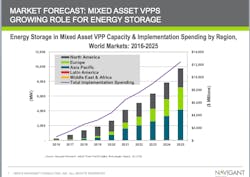When are microgrids virtual power plants, and what change do they bring to the central grid?
The market for virtual power plants, and the technologies that enable them, are growing quickly, in large part driven by the lower costs of solar and energy storage. Thanks to these cost declines, we’re seeing more and more distributed energy coming online.
Virtual power plants provide a way of managing all those two-way power resources, according to a new report from Navigant Research.
In fact, Navigant expects spending to reach $2.1 billion by 2025 for implementation of the technology (excluding energy storage).
But that’s not the only significant news in the report. The energy storage industry comes out the biggest winner in spending. Navigant forecasts that spending will reach $12.4 billion annually in 2025 on energy storage associated with virtual power plants.
Navigant defines virtual power plants as technology that “relies on software and the smart grid, working remotely and automatically to combine a diversity of independent resources into a network.”
Virtual power plants use sophisticated planning, scheduling, and bidding of distributed energy resources.
They can stitch together different energy resources from different locations and aggregate them to provide reliable power 24 hours a day, much like a coal plant provides reliable power, explained Peter Asmus, principal research analyst with Navigant Research.
When are microgrids virtual power plants
A microgrid tends to be more inward-looking and static than a virtual power plant, said Asmus.
A virtual power plant can only be created if there is a market to sell its power and services to, he said. “It’s highly dependent on regulations.”
A microgrid, on the other hand, can be created anywhere, and isn’t as dependent on market structures. And it can island from the main grid, while virtual power plants can’t.
However, once a microgrid starts to sell its services—such as demand response—it becomes a virtual power plant.
Navigant Forecast About VPPs CREDIT: Navigant
The uptick in the amount of storage used in virtual power plants marks a big change in Navigant’s research about the plants, Asmus noted.
“When we did our first report on virtual power plants (in 2013), usually the virtual power plants were created because there was no storage available,” he said. The goal was to combine different resources to create a ‘plant’ that could provide power 24 hours a day.
“What has changed now is all the solar and battery systems installed. One of the main new trends is solar nanogrids, which are similar to microgrids but are in single homes. You can aggregate them into a single power plant.” Companies like Tesla and its new unit, SolarCity, are big players in this market, aggregating renewable energy and energy storage systems, he added.
When these solar nanogrids, operating as virtual power plants, provide value to the grid, they’re not seen as being threatening to utilities, Asmus noted. They don’t contribute to what’s termed the “utility death spiral.”
In the US, virtual power plants are often used to provide demand response, and PJM has the most active demand response market. Texas and California are also leaders in demand response and virtual power plant implementation, he said.
As far as providing supply-side resources through virtual power plants, Germany is the leader, Asmus noted.
Manifestation of transactive energy
Navigant said that virtual power plants can be viewed as “a manifestation of transactive energy.” New technologies such as demand response, solar PV systems, advanced batteries, and electric vehicles “are transforming formerly passive consumers into active prosumers.” The goal of a virtual power plant is to reap profits for the assets’ owners while ensuring the grid is properly balanced, at low economic and environmental costs, according to the report’s executive summary.
Virtual power plants require no large infrastructure upgrades. They can stretch supplies from existing generators and distributed energy resources, such as demand reduction programs, according to the report.
The Navigant Research report divides the virtual power plant market into three segments: demand response, supply-side, and mixed asset.
“If there’s storage involved, it’s a mixed asset,” explained Asmus. “Mixed asset is now the largest market, which happened quicker than we expected because of the declining cost of storage.”
The study examines market issues associated with virtual power plants. It also offers global market forecasts for implementation spending, divided into segment, region and technology, through 2025. The report puts a number on the capacity growth of energy storage devices in emerging markets for mixed-asset virtual power plants and also takes a look at associated technology issues.
The report is available for a fee. A free executive summary is here.
Read more on Microgrid Knowledge’s new virtual power plant channel.








